Table of Contents
|
Spires on the Hill
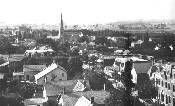 |
| Picture post card village.
Photograph taken from the tower of the
Presbyterian Church, circa 1900, looking north up
Yonge Street, with
the spire of the
Methodist Church in the centre. |
"Few villages of equal size or importance within the
Province,"
The Liberal proudly announced in August
1881, "have manifested so much activity and energy in church enterprise as our
own." The
Presbyterians of Richmond
Hill, argued the editorial, "can boast a
church which would do credit to places of larger
pretensions, and on a site unequalled for beauty." Immediately south of the
Presbyterians stood
St. Mary's
Anglican Church, which had just installed an organ, "costing between six
and seven hundred dollars, which in appearance and tone would reflect credit
upon any city church." Meanwhile, across
Yonge Street and to the
north, the new
Methodist
Church was deemed "one of the finest Church edifices in the
Province."
The Liberal totalled up some $25,000
invested in local church enterprises during the preceding year, in addition to
clerical salaries, in a village of fewer than one thousand inhabitants. This
was "an almost unprecedented thing, and speaks volumes for religious vitality
of the community." The paper justifiably concluded that church matters "are not
regarded as a secondary thing to secular business by the people of our
village."
1
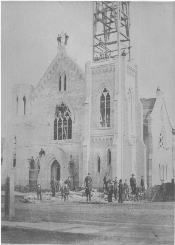 |
| Building the
Richmond Hill Methodist (later United) Church in 1880-81. |
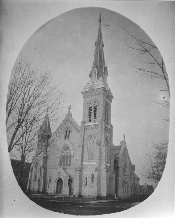 |
| The completed
Methodist Church, dedicated in October 1881. |
Necessity lay behind much of this recent capital
investment in
Richmond Hill's
spiritual properties - especially for the
Methodists.
On December 21, 1879,
Methodist minister Reverend J.W.
McCallum took as
the text for his morning sermon, "Behold how great a matter a little fire
kindleth." In speaking of the accidents of life,
McCallum asked the
rhetorical question: "Who knows, how soon fire may overtake us?" Little did he
know how fitting his text was. At the very moment he was preaching, fire was
burning in the
Sunday School room a few feet behind him. Just after the
congregation left the sanctuary, flames burst through the roof, and the
Richmond
Hill Methodist Church with all its contents burned to the ground.
 |
| Abraham Law's
quarterly ticket (comparable to a twentieth-century communion card) for the
Richmond Hill Methodist Church, 1884. |
Fortunately, the
Methodists numbered
among their congregation many of the village's prosperous business families.
Exactly one month after the disastrous fire, tannery owner and ex-reeve
Abraham Law sold a
half-acre of land (about one-fifth of a hectare) at the corner of
Yonge Street and
Centre Street East
for a new building. Carriage maker
William
Trench, saddler
William
Harrison, dry goods merchant
Isaac Crosby, and
other leaders of the congregation also pitched in.
Soon a new $17,000 building was under construction.
Cornerstones were laid on May 24, 1880, a mere five months after the fire, and
the building was dedicated in October of the following year.
William Harrison
described it in an article for
The Liberal as a "beautiful new
church, which for lofty spire, great seating capacity,
excellent organ and splendid acoustics, is exceeded by few churches north of
Toronto."
2
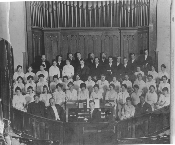 |
| Choir at the dedication of a new
organ at the
Richmond Hill Presbyterian Church in 1915. Pictured left to
right are:
J.H. Dunlop,H. Rowley,L. McNair,James Stewart,A.L.
Phipps,Joseph
Atkinson,George Sims,Ira Ramer,W. Robinson,J. Aikenhead,W. Oliver,D. Cooper,Tom Scott,Miss E.
Gordon,Miss Douglas,Dr.
L. Langstaff,Mrs. E.
Newton,Mrs. A.L. Phipps,Mrs. Sterling,Miss Pentland,Miss E. Mcnair,Miss M. Cooper,Miss Hammond,Miss Margaret
Moodie,Mrs. R.
Cooper,Miss P. Batty,Miss H. Lang,Mrs. Mckenzie,Mrs. J. Innes,Mrs. Amos
Wright,Miss Heise. Three
top right are
Mrs. Scott,Mrs. J.
Atkinson,Miss Boyle. Front
row:
Miss D.
Mckenzie,Miss Carol
Innes,Miss J. Lomas,Mrs. W.
Oliver,Mrs. Simpson,Mrs. Godwin,Miss G. Prett,Mrs. Van Wart,Mrs. Allen,
unknown,
Miss V.
Jennings,Miss L. Innes,Reverend R.
Herbison,F. Converse
Smith,J.E. Newton,Miss Sisman,E. Caldwell. |
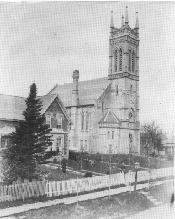 |
| Presbyterian Church and
manse, with
Reverend W. Webb
Percival, his wife, and son. Percival ministered to the
Richmond Hill
congregation from 1887 to 1894. |
Such superlatives for the
Methodists helped spur
on the rival
Presbyterians who
were building a new structure at the same time. The old wooden
Presbyterian church building of 1821 had served the
congregation well. But it was now almost sixty years old and suffered in
comparison with its neighbour,
St. Mary's
Anglican Church, and the proposed
Methodist edifice. So on January 15, 1880, the
Presbyterians voted
to build a new
church. Within two weeks, a building committee was named
and some $4,800 subscribed in pledges. Cornerstones were laid on July 1, and
despite problems with the contractor, the new structure was officially opened
on May 24, 1881.
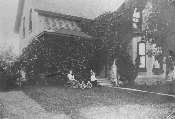 |
| Reverend James
Grant, his wife, and children
Robert,Reay, and
George, pictured
in front of the Presbyterian
manse. Grant ministered to the
Richmond Hill
congregation from 1894 to 1909. |
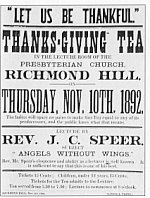 |
| Sparing "no pains," the ladies of
the
Richmond Hill Presbyterian Church promise to make an 1892
afternoon tea "equal to any of its predecessors." |
The result was a handsome Gothic building of buff-coloured
brick with a decorative red-brick design, boasting an imposing tower, complete
Sunday School facilities, and a sanctuary seating 410 on
the floor and another 70 in the gallery - all for a bargain cost of only
$6,366! Situated on the crest of the hill, the square, four-turreted, 34-metre
(110-foot) tower was clearly visible for several kilometres in all directions.
And more than a century later, despite the many high-rise apartment buildings
of the modern town, that
Presbyterian Church tower still dominates the skyline of
Richmond Hill.
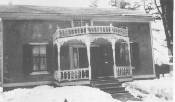 |
| St. Mary's
Anglican Church rectory, with
Mrs. H.F.
Battersby on verandah. The rectory stood on the site of the later
Langstaff Building. |
Though necessity certainly drove the
Methodists, and to some
extent motivated the
Presbyterians, there
was also the challenge of keeping up with the Church of England.
St. Mary's
Anglican Church had been erected in 1872 on property immediately south
of the
Presbyterians - land
once owned by
Abner Miles and
donated to the
church
by his grandson,
John
Arnold. The
church
was built in the English decorative style, a scaled-down version of St. James
Cathedral in Toronto. With their attractive new building and their new organ
"costing between six and seven hundred dollars," under the leadership of the
much-loved
Reverend Robert
Shanklin,Richmond Hill'sAnglicans threatened to
outdo the village's other denominations.
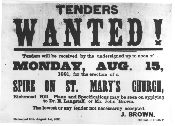 |
| Calling for tenders for a spire
for
St. Mary's
Anglican Church, August 1881. |
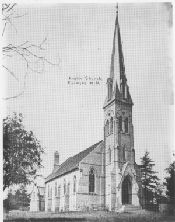 |
| St. Mary's
Anglican Church, after completion of spire. |
But
St. Mary's
Anglican needed a spire or tower - that most important attribute of any
late-nineteenth-century church - and to keep pace with the new
Methodist and
Presbyterian buildings, the
Anglicans in the early
1880s decided to add one to their structure. The spire proved to be a costly
project, however, and the
Anglican congregation
could not draw on as much wealth as their rivals. The spire was built, but
St.
Mary's continually struggled with financial problems and did not become
a self-supporting parish until after the
First World
War.
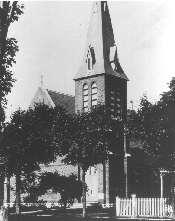 |
| St. Mary Immaculate Roman Catholic Church, original
structure built in November 1857; this building erected in 1894. |
Richmond Hill'sRoman Catholics
lagged behind the
Methodists,Presbyterians, and
Anglicans in numbers, in
wealth, and in grand structures throughout the nineteenth century.
The Liberal's 1881 article
on village churches, for instance, did not even mention the
Catholics. But
under the spiritual guidance of a succession of non-resident priests and the
temporal leadership of postmaster and village clerk
Matthew Teefy, the
Catholic parish of
St. Mary Immaculate laboured on. The old
church on
Mill Street was
enlarged in 1874, then replaced twenty years later by a $5,000 larger structure
on the northeast corner of today's Yonge and
Dunlop streets.
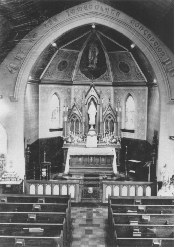 |
| Interior of
St. Mary Immaculate Roman Catholic Church, 1894 |
At the June 1894 cornerstone laying for their new
building,
St. Mary Immaculate parishioners listened to a sermon
preached by
Reverend John Teefy.
Reverend
Teefy was a prominent
Basilian priest and superior at St. Michael's College, Toronto. But to
St. Mary's parishioners, and to all
Richmond Hill
residents, the forty-five-year-old priest was best known as young
John Teefy the
postmaster's son, and the first priest ordained from the parish.
 |
| Advertising the annual picnic of
St. Mary Immaculate Roman Catholic Church. |
Richmond Hill's
several churches offered more than Sunday worship services; they also provided
outlets for a wide variety of community enthusiasms. There were Sunday School
classes for children and teenagers, and choirs for the musically inclined.
Upstanding village men solidified their church boards and committees.
And for many women, the steady round of bake sales,
afternoon teas, and church suppers provided the sole opportunity for any kind
of organized social activity within the community.
As these churches prospered through the 1880s and
1890s, they easily replaced the mid-century hotel as the distinguishing feature
of village life. In fact, with the decline
of the coaching trade and the rise of the temperance and prohibition movements,
Richmond Hill's
hospitality industry was a mere shadow of its former self - with a few notable
exceptions such as the
Palmer House
and, to the north, the
Elgin Mills
Hotel and
Bond Lake Hotel.
But where once the
Yonge Street traveller
stopped at one of the town's many hotels, inns, and taverns for food and drink,
now community residents on their journey through life stopped regularly at one
of the churches for spiritual replenishment.
This shift from hotel to church domination is
illustrated in the saga of the "town bell" and its
dramatic relocation in 1883. The town bell was used
to warn of fires and to regulate the working day, presumably for those who had
no watches or clocks to tell the hours. It was also a favourite target for
pranksters, usually late at night or very early in the morning! Through the
1870s the bell was located over the
Robin Hood
Hotel, on
Yonge Street towards
the south end of the village, and was tended by the hotel's successive owners
as a free public service.
But following the construction of the new
Methodist
Church, and the installation of a new half-ton bell in its tower in
1881, council made arrangements with the
church to use this bell for village purposes. Besides being
more "respectable" than the old
Robin Hood
Hotel, the
Methodist
Church stood farther north and on higher ground. Regardless of
denomination, residents of the North End could now hear the
town bell as clearly as their South End cousins.
From 1883 to 1897 sexton
Francis Wiley of
the
Methodist
Church served as the municipality's paid bell ringer.
By the end of the 1890s,
Richmond Hill's most
definitive physical structures were its four substantial churches. Travellers
journeying north on
Yonge Street spotted
these landmark edifices long before other village buildings came into view. On
the left, on the rise north of
Major Mackenzie
Drive, the spire of
St. Mary's
Anglican Church and the tower of
Richmond
Hill Presbyterian Church soared heavenwards. Farther north, on the right
side of
Yonge Street, the
Richmond
Hill Methodist Church and
St. Mary Immaculate Roman Catholic Church announced their
presence. The elevation, the churches, and the profusion of spires and towers
combined to make
Richmond Hill a
picture-postcard-perfect village of the late nineteenth century.
Notes
1.
The Liberal,August 12, 1881.
2.
William Harrison,"Richmond Hill and Vicinity, Number
33," Richmond Hill Public Library, Local History
Collection.
Previous
Next
Copyright © Richmond Hill Public Library Board, 1991
|

